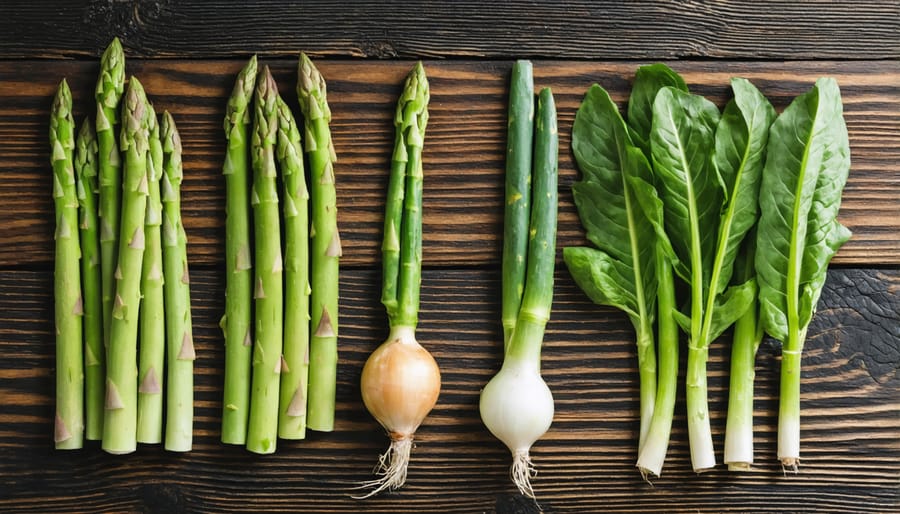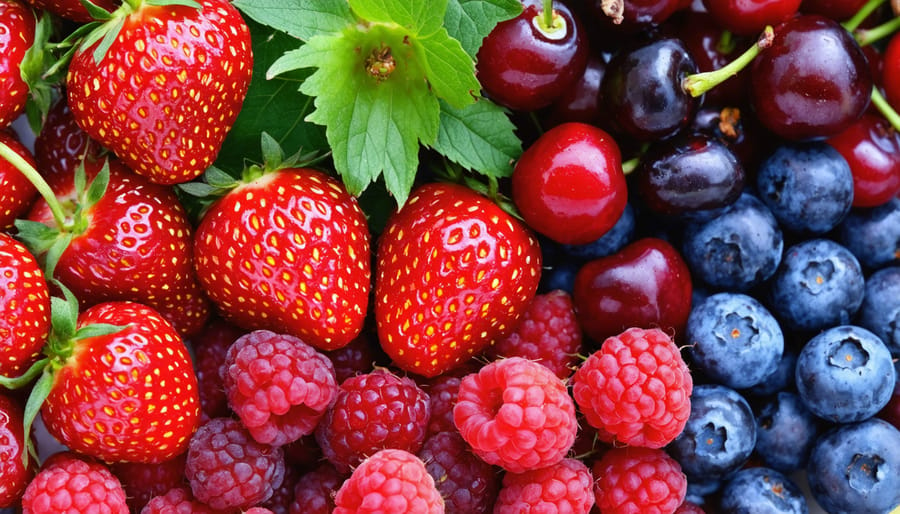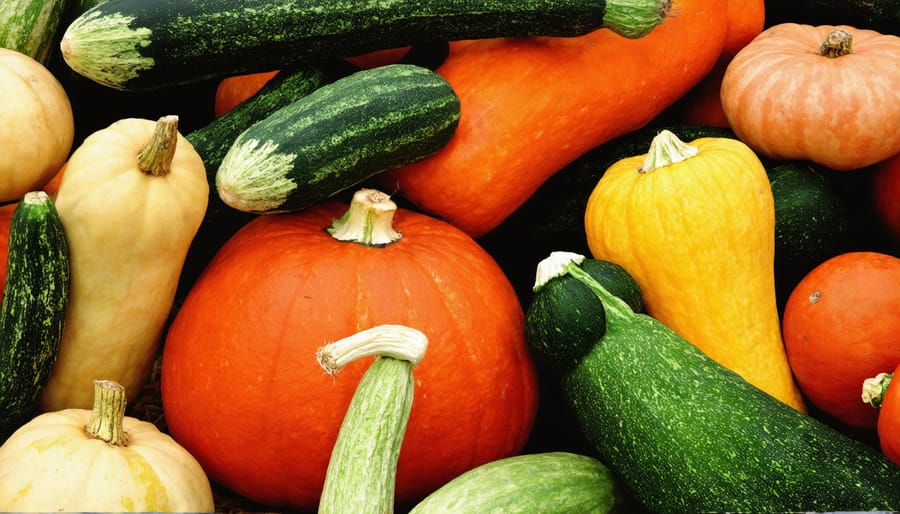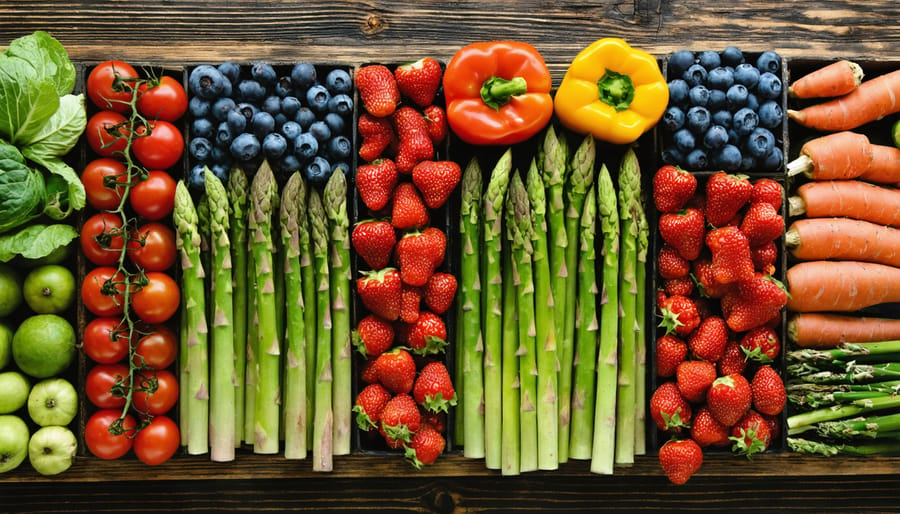Unlock Oregon’s agricultural bounty with our comprehensive farmers market calendar, designed to help you eat locally and seasonally throughout the year. From Hood River’s succulent berries in summer to Willamette Valley’s hearty winter squash, Oregon’s diverse growing regions offer an ever-changing feast of fresh, local produce. This seasonal guide empowers you to make informed choices at markets, plan your garden plantings, and support local farmers while enjoying peak-flavor fruits and vegetables. Whether you’re a home cook passionate about farm-to-table dining, a market vendor planning your growing schedule, or simply someone who loves fresh, nutritious food, understanding Oregon’s seasonal rhythms helps you make the most of each month’s harvest. Our color-coded chart breaks down availability by month, making it simple to track when your favorite local produce reaches its prime.
Spring Bounty (March-May)

Early Spring Favorites
As winter’s chill gives way to spring warmth, Oregon’s farms burst into life with the first harvests of the season. Asparagus leads the charge, pushing through warming soil with tender spears that signal nature’s awakening. These fresh stalks offer a sweet, grassy flavor that’s unmatched by store-bought varieties, perfect for grilling or quick-steaming.
Spring onions follow close behind, delivering a milder, more delicate taste than their mature counterparts. These versatile alliums add a gentle bite to salads and stir-fries, with both bulbs and green tops being equally delicious. Local farmers often harvest them young, ensuring peak flavor and tenderness.
Early greens transform Oregon’s markets into a celebration of verdant flavors. Look for baby spinach, tender leaf lettuce, and peppery arugula – all thriving in the cool spring temperatures. These greens grow particularly well in Oregon’s climate, often appearing first in hoop houses before transitioning to open fields. Watercress and young kale varieties also make their debut, offering nutrient-rich options for health-conscious shoppers.
Remember to handle these delicate spring vegetables with care, as their tender nature requires gentle treatment from market to table.
Late Spring Treasures
As spring transitions into early summer, Oregon’s fields and gardens burst with some of the season’s most anticipated treasures. Sweet, ruby-red strawberries take center stage, with Hood River and Willamette Valley farms producing some of the most flavorful berries you’ll ever taste. These local strawberries, smaller and more intensely flavored than their commercial counterparts, are perfect for fresh eating, preserving, or adding to desserts.
Tender peas emerge in abundance during this time, including snow peas, sugar snap peas, and traditional English peas. Fresh from the vine, they offer a crisp sweetness that celebrates the season. Many Oregon farmers use sustainable trellising methods to grow their peas, maximizing space while ensuring optimal flavor development.
The mild spring weather also brings forth an explosion of fresh herbs. From fragrant basil and cilantro to hardy oregano and thyme, these aromatic plants thrive in Oregon’s climate. Local farmers markets overflow with bundles of these culinary essentials, perfect for adding fresh flavors to your spring dishes. For the best results, look for bright, perky leaves and strong stems when selecting your herbs.
Summer’s Peak Season (June-August)
Berry Bonanza
Oregon’s summer bounty reaches its peak with an explosion of vibrant berries and stone fruits. From June through September, local farms burst with sweet treasures like strawberries, blackberries, and marionberries – a unique Oregon variety that perfectly captures our region’s terroir. Blueberries typically arrive in July, offering antioxidant-rich snacking opportunities well into August.
Stone fruits join the party in mid-summer, with cherries leading the charge in June, followed by succulent peaches, plums, and nectarines in July and August. Many local orchards offer U-pick experiences, allowing families to connect directly with their food source while enjoying a memorable day out.
For the best berry experience, visit farmers markets early in the morning when produce is freshest. Local tip: freeze excess berries at peak ripeness for year-round enjoyment. Most berries freeze beautifully and retain their nutritional benefits, making them perfect for smoothies, baking, or topping your winter oatmeal. Remember that availability can vary slightly based on weather conditions and specific microclimates throughout the state.

Garden Vegetables
Oregon’s warm summer months bring an abundance of vibrant garden vegetables to local markets and farm stands. Tomatoes take center stage from July through September, with heirloom varieties offering rich flavors and stunning colors you won’t find in grocery stores. Cherry tomatoes typically appear first, followed by beefsteaks and paste tomatoes perfect for canning.
Peppers flourish during the same period, with sweet bell peppers available in green, red, yellow, and orange varieties. For heat lovers, local farmers grow everything from mild jalapeños to scorching hot habaneros. Many Oregon farmers also cultivate specialty peppers like shishitos and Jimmy Nardellos, adding unique options to the seasonal mix.
Summer squash starts producing early and continues through fall. Look for tender yellow crookneck squash, versatile zucchini, and decorative patty pan varieties. These prolific plants often lead to abundant harvests, making them excellent value at farmers markets. For best flavor and texture, choose smaller squash with bright, unblemished skin and firm flesh.
These garden favorites peak during August when days are longest and temperatures highest, offering optimal growing conditions in Oregon’s climate.

Fall Harvest (September-November)
Root Vegetables
Oregon’s rich soil and diverse climate create ideal conditions for growing a variety of root vegetables throughout the year. Potatoes thrive in the state’s volcanic soil, with peak harvest occurring from July through October. Look for distinctive varieties like Russian Banana fingerlings and All-Blue potatoes at local markets.
Carrots are available nearly year-round, with the sweetest crops harvested in fall after the first frost. Winter storage varieties keep well through spring, making them a reliable local staple. Other root vegetables that flourish in Oregon include parsnips, turnips, and rutabagas, which are typically harvested from late summer through winter.
Beets deserve special mention, offering both their flavorful roots and nutritious greens. They’re available from June through December, with peak season in fall. For the freshest root vegetables, look for firm texture and bright, unblemished skin. Many Oregon farmers practice crop rotation with root vegetables to maintain soil health and ensure sustainable production.
Storage tip: Most root vegetables keep best in cool, dark places with good air circulation. Remove leafy tops before storing to extend freshness.
Winter Squash and Pumpkins
Oregon’s rich soil and climate create ideal conditions for growing a variety of winter squash and pumpkins, typically harvested from late September through November. Popular varieties include the sweet and versatile Butternut squash, the compact and flavorful Acorn squash, and the uniquely shaped Delicata with its edible skin. Sugar Pie pumpkins are a local favorite for making homemade pies and seasonal treats.
These hardy vegetables are excellent storage crops, often lasting several months when kept in cool, dry conditions between 50-55°F. Most winter squash varieties will keep for 3-6 months, while properly stored pumpkins can last up to 4 months. Look for squash and pumpkins with hard, unblemished rinds and intact stems for the longest storage life.
Local farmers markets typically offer the freshest selection in early fall, though stored varieties remain available through winter. Beyond their culinary uses, these nutritious vegetables are rich in vitamins A and C, fiber, and antioxidants. Try roasting them with local honey and herbs, or incorporate them into hearty soups and stews during Oregon’s chilly months.
Winter Offerings (December-February)
Oregon’s winter months bring a surprising abundance of hardy produce and storage crops that keep local food systems thriving even during the coldest season. Root vegetables take center stage, with locally grown carrots, parsnips, turnips, and potatoes offering hearty nutrition throughout the winter. These underground treasures are joined by winter squash varieties like butternut, acorn, and delicata, which store beautifully when harvested in fall.
Leafy greens continue to grace our plates thanks to cold-hardy varieties and greenhouse cultivation. Kale, collards, and Swiss chard actually become sweeter after exposure to frost, while spinach and arugula thrive in protected growing environments. Brussels sprouts stand tall against winter storms, often improving in flavor as temperatures drop.
Storage onions, garlic, and shallots provide essential flavoring components, while local mushrooms flourish in Oregon’s damp winter conditions. You’ll find wonderful varieties of oyster, shiitake, and lion’s mane mushrooms at winter farmers markets across the state.
Don’t forget about preserved items that bridge the seasonal gap. Many farms offer dried herbs, frozen berries, and value-added products like pickles and preserves. Fresh microgreens and sprouts, grown year-round in indoor facilities, add bright flavors and vital nutrients to winter meals.
For the best winter shopping experience, look for farms that utilize season extension techniques like hoop houses and cold frames. These methods help extend the growing season and ensure a steady supply of fresh, local produce even during Oregon’s chilliest months.
Shopping Tips for Market Success
To make the most of Oregon’s seasonal bounty, timing your market visits is crucial. Early morning shopping ensures the best selection, while late afternoon might offer better deals. Bring reusable bags and cash, as some vendors may not accept cards. Before making purchases, take a lap around the market to compare prices and quality, noting which vendors have the freshest produce and most appealing seasonal market displays.
Don’t hesitate to ask vendors about their growing practices and request storage tips for specific items. Many farmers are happy to share recipes and preparation suggestions. For the best value, consider buying in bulk when your favorite items are at peak season – many vendors offer case discounts. You can preserve extras through freezing, canning, or dehydrating.
Build relationships with regular vendors; they often reserve premium produce for loyal customers and may alert you when special items become available. Shopping with a flexible menu in mind allows you to take advantage of unexpected finds and weekly specials, maximizing both savings and seasonal eating opportunities.
Shopping seasonally in Oregon not only guarantees the freshest, most flavorful produce but also supports our local farming community. By choosing seasonal fruits and vegetables, you’ll enjoy better prices, superior taste, and the satisfaction of reducing your environmental footprint. Remember, every seasonal purchase helps sustain Oregon’s rich agricultural heritage and keeps our local farmers thriving for generations to come. Make your next shopping trip count by choosing what’s in season!

